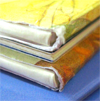|
|
|
|
|
|
|

| 최근 이 책을 구매하신 다른 회원의 책장 |
|
 |
|
|
|
[ 책 소개 ]
우리가 살고 있는 지구에 대한 포괄적인 이해를 돕는 책입니다.
둥근 지구의 북쪽 끝은 북극, 남쪽 끝은 남극이며 매우 춥습니다.
지구는 물, 불, 얼음, 생명체들에 의해 형태를 만들어 가고 있으며, 지금도 계속 변화하고 있습니다.
가장 큰 땅덩어리를 대륙이라 부르며, 바다에 떠있는 조그만 땅은 섬이라고 부릅니다. 섬은 화산 폭발로 인해 만들어지기도 하고, 산호들이 쌓여서 만들어 지기도 합니다.
땅 속에서 솟은 물, 빗물, 눈이 녹은 물 등은 흘러가면서 하천과 연못과 호수를 만들고결국 바다로 흘러 들어 갑니다.
육지는 다양한 형태를 지니고 있습니다. 열대우림지역, 사막지역, 동굴, 대협곡, 고산지대... 하지만 어떤 형태든 지구는 아름다운 곳이며, 우리와 수많은 생명체들이 함께 살아가는 소중한 곳입니다.
튼튼한 | 닫기x |  What is 하드커버? What is 하드커버?
양장본이라고도 불리우며, 표지가 단단한 판지로 만들어진 책입니다.
판지를 천이나 가죽으로 감싸기도 합니다. 책의 속지는 일반적으로 중성처리된 종이(Acid-free paper)를 사용해서 잘 변질이 되지 않기 때문에 오랫동안 보관하기에 적합합니다. 이 종류의 책은 더스트 재킷, 또는 더스트 커버로 불리는 표지덮개가 함께 있는 경우가 많습니다. 간혹 내부 속지가 콩기름 코팅이 된 경우 고약한 냄새가 나는 책도 있습니다.
|
[ 서지 정보 ]
Hardcover: 24 pages
ISBN-10: 0152016791
ISBN-13: 978-0152016791
책 크기: 23.5cm x 23.5cm
[ 영문 서평 ]
Book Description
From frozen polar ice caps to steamy tropical rain forests, the earth is home to all kinds of plants and animals. Earth has steep mountains, green valleys, rushing rivers, and deep canyons. It has dark caves, sandy deserts, and brilliant coral reefs. Gentle, rhythmic text introduces earth science concepts, while bright illustrations transport readers to exotic natural habitats.
From School Library Journal
The statement "Our earth is where I live" appears under a picture of a suburban home with dandelions on the lawn. On the opposite page, a picture of the planet is labeled, "It is a big, round globe." So begins this first look at the development of the earth and its geographic components. Simple sentences state very basic information about the North and South Poles, how an island is born, the path water takes to the sea, hot deserts, damp caves, high mountains, and tropical forests. Grasslands are not included. The watercolor-and-gouache illustrations are colorful, in Rockwell's typical flat, uncomplicated style. The pictures extend the text with appropriate details-an ocean teeming with brightly colored coral and fish, a tranquil cow pasture with rock walls and a red barn, lizards in the desert, and bats in a cave. After such an introduction, preschoolers can move on to Jack Knowlton's Geography from A to Z (Crowell, 1988).
From Booklist
Rockwell takes on an ambitious project as she introduces the earth to young children. Although the illustrations succeed in suggesting the variety of physical features and landscapes on the earth, the text is a mundane accompaniment. The subject is so large and complex that writers attempting to express it in a picture book must chart a course between two hazards: telling too much and losing the audience, or telling too little and sounding simplistic. Rockwell veers toward the latter, and the result is a sentence like this: "Some islands are coral reefs that grow and grow until they poke above the water, and birds bring seeds to them." Children who have no idea what coral is, how or why birds bring seeds to the coral, or what seeds have to do with making an island will need further interpretation. However, the watercolor-and-gouache illustrations are very accessible. The pictures should provoke questions; parents and teachers can use the answers to provide kids with more information. Useful for many library collections. |
|
|
|
|
|
|
|
|